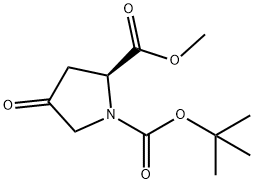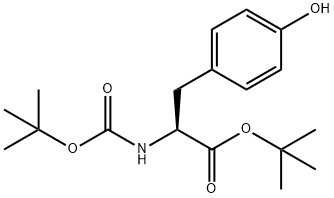N-Boc-4-oxo-L-Proline methyl ester
Synonym(s):(2S)-4-Oxo-1-(tert-butoxycarbonyl)pyrrolidine-2-carboxylic acid methyl ester;tert-Butyl (2S)-2-(methoxycarbonyl)-4-oxopyrrolidine-1-carboxylate;1-tert-Butyl 2-methyl (2S)-4-oxopyrrolidine-1,2-dicarboxylate
- CAS NO.:102195-80-2
- Empirical Formula: C11H17NO5
- Molecular Weight: 243.26
- MDL number: MFCD01861778
- EINECS: 625-165-1
- SAFETY DATA SHEET (SDS)
- Update Date: 2025-07-24 18:13:41

What is N-Boc-4-oxo-L-Proline methyl ester?
Chemical properties
Yellow Solid
The Uses of N-Boc-4-oxo-L-Proline methyl ester
(2S)-1-Boc-4-oxo-proline Methyl Ester (cas# 102195-80-2) is a compound useful in organic synthesis.
Properties of N-Boc-4-oxo-L-Proline methyl ester
| Melting point: | 35-40°C |
| Boiling point: | 333.1±42.0 °C(Predicted) |
| alpha | 14 º (C=1 IN CHLOROFORM) |
| Density | 1.209±0.06 g/cm3(Predicted) |
| Flash point: | 110 °C |
| storage temp. | -20°C |
| solubility | Soluble in Chloroform,Dichloromethane,Ethyl Acetate,DMSO,Acetone,etc. |
| form | Powder |
| pka | -3.86±0.40(Predicted) |
| optical activity | [α]22/D +14.0°, c = 1 in chloroform |
| CAS DataBase Reference | 102195-80-2(CAS DataBase Reference) |
Safety information for N-Boc-4-oxo-L-Proline methyl ester
| Signal word | Danger |
| Pictogram(s) |
 Corrosion Corrosives GHS05  Exclamation Mark Irritant GHS07 |
| GHS Hazard Statements |
H318:Serious eye damage/eye irritation |
| Precautionary Statement Codes |
P280:Wear protective gloves/protective clothing/eye protection/face protection. |
Computed Descriptors for N-Boc-4-oxo-L-Proline methyl ester
| InChIKey | UPBHYYJZVWZCOZ-QMMMGPOBSA-N |
New Products
4,4-Difluoropiperidine hydrochloride tert-butyl 9-methoxy-3-azaspiro[5.5]undecane-3-carboxylate Indole Methyl Resin N-Isopropylurea N,N-Dicyclohexylcarbodiimide(DCC) MELDRUMS ACID 5-METHYLISOXAZOLE-4-CARBOXYLIC ACID Magnessium Bis glycinate Zinc ascorbate 1-bromo-2-butyne 2-acetamidophenol 9(10H)-anthracenone Erythrosin B, 4-Piperidinopiperidine 2-((4-morpholinophenylamino) (methylthio) methylene) malononitrile 2,4-dihydroxybenzaldehyde 3-(4-morpholinophenylamino)-5-amino-1H-pyrazole-4-carbonitrile Methyl 2-methylquinoline-6-carboxylate 2,6-dichloro-4-nitropyridine 4-Bromo-2-chlorobenzonitrile 2-(benzylamino)acetic acid hydrochloride 4-(tert-Butoxycarbonylamino)but- 2-ynoic acid 3,4-dihydro-2H-benzo[b][1,4]dioxepine 1-Phenyl-1-cycloprppanecarboxylicacidRelated products of tetrahydrofuran








You may like
-
 N-Boc-4-oxo-L-Proline methyl ester 95% CAS 102195-80-2View Details
N-Boc-4-oxo-L-Proline methyl ester 95% CAS 102195-80-2View Details
102195-80-2 -
 N-Boc-4-oxo-L-proline methyl ester 98% (GC) CAS 102195-80-2View Details
N-Boc-4-oxo-L-proline methyl ester 98% (GC) CAS 102195-80-2View Details
102195-80-2 -
 N-Boc-4-oxo-L-proline methyl ester CAS 102195-80-2View Details
N-Boc-4-oxo-L-proline methyl ester CAS 102195-80-2View Details
102195-80-2 -
 3-(4-amino-1-oxoisoindolin-2-yl)-1-methylpiperidine-2,6-dione 98%View Details
3-(4-amino-1-oxoisoindolin-2-yl)-1-methylpiperidine-2,6-dione 98%View Details -
 20677-73-0 (2,2-diethoxyethyl)methylamine 98%View Details
20677-73-0 (2,2-diethoxyethyl)methylamine 98%View Details
20677-73-0 -
 3-(4-(hydroxyamino)-1-oxoisoindolin-2-yl)piperidine-2,6-dione 98%View Details
3-(4-(hydroxyamino)-1-oxoisoindolin-2-yl)piperidine-2,6-dione 98%View Details -
 57381-49-4 2-bromo-4-chlorobenzonitrile 98%View Details
57381-49-4 2-bromo-4-chlorobenzonitrile 98%View Details
57381-49-4 -
 4,6-dichloropyrimidine-5-carbaldehyde 98%View Details
4,6-dichloropyrimidine-5-carbaldehyde 98%View Details
5305-40-8
Statement: All products displayed on this website are only used for non medical purposes such as industrial applications or scientific research, and cannot be used for clinical diagnosis or treatment of humans or animals. They are not medicinal or edible.
